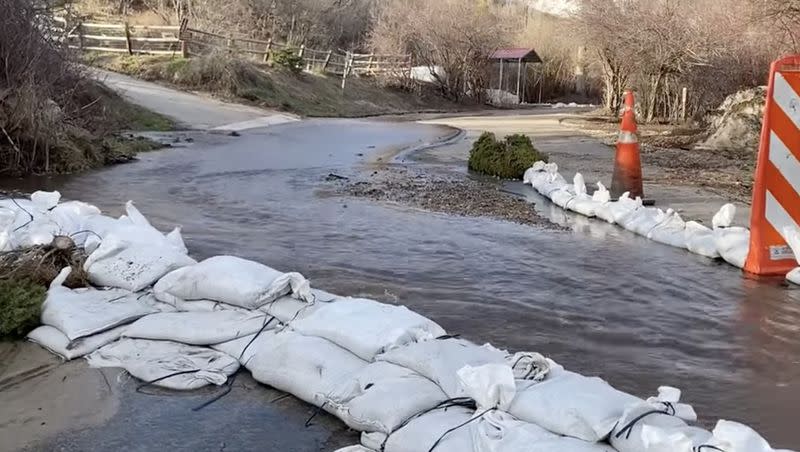Flooding, avalanches impact communities in Utah as record temperatures continue

Flooding and avalanche risks continue to impact parts of Utah on Monday after an active weekend, as record-high temperatures are causing major chunks of the state's record snowpack to melt rapidly.
Both directions of U.S. 89 are closed between U.S. 6 and Fairview because of flooding on the roadway in the area, according to the Utah Department of Transportation. The National Weather Service had issued a flood advisory for Thistle Creek near the U.S. 6 junction in Utah County on Monday morning, noting that snowmelt will likely cause hydrologic flooding, possibly making roadways impassable.
The agency also issued flood warnings for the Little Bear River at Paradise in Cache County and Emigration Creek in Salt Lake City's east bench, which remains in place because streamflows are currently exceeding flood status in both areas. Flooding in Emigration Canyon began Sunday evening, as the creek began flowing above its banks and closer to homes and businesses like Ruth's Diner in the area.
In addition to the active flood warnings and advisories, flood watches remain in place for East Canyon Creek (near Jeremy Ranch downstream to East Canyon Reservoir), the Little Bear River (below Hyrum Dam to Cutler Reservoir) and the Lower Weber River (at Plain City).
Uphill traffic into Little Cottonwood Canyon is also currently closed because of avalanche mitigation efforts, according to UDOT. Uphill traffic into Big Cottonwood Canyon will be closed from 11 a.m. to 5 p.m., as well.
The flooding and avalanche concerns come as Utah's record snowpack is finally melting in earnest across the state. The statewide figure dropped another 3.8 inches over the past five days, slipping to 22.7 inches of water by Monday morning, according to Natural Resources Conservation Service data. The statewide snowpack peaked at 30 inches on April 8; however, it only dropped 3.5 inches between then and last Wednesday.
Utah's current statewide figure also fell out of record status over the weekend, the first time it has not been in uncharted territory since March 15. That means there is finally less water in Utah's statewide snowpack than there was at this point in the year back in 1983.
More snowpack runoff is expected this week, even in areas outside of current warnings and watches. The National Weather Service advises that there is a "high chance" of localized flooding in some mid-elevation watersheds again over the next few days, especially in northern Utah, as it happens.
"Streams, creeks, and rivers will continue to experience significant rises moving forward throughout the upcoming week, especially low and mid-elevation watersheds across (the state)," the agency wrote in an advisory Sunday.
Record-high temperatures persist in Utah
Salt Lake City set a new daily record on Sunday when temperatures reached 87 degrees. Records or unseasonably hot temperatures were also recorded all over the state this weekend, which is fueling the runoff.
KSL meteorologist Matt Johnson said temperatures might reach 90 degrees in Salt Lake City on Monday, which would break a record for the earliest 90-degree day in the city's history. The current record was set on May 2, 1947, and has held for the last 149 years that have been tracked by the National Weather Service.
Johnson explained that record-high temperatures result from air mass patterns in the West. A low-pressure system off the Pacific Coast in California is helping pump "warm, dry desert air" from the south into Utah and other parts in and around the Great Basin where a high-pressure system moved in over the weekend.
Clouds and scattered showers are possible in parts of the state the next three days, before the next cooldown arrives in the form of rain and possibly thunderstorms.
"Our best chance to see some showers and cooler weather isn't until Thursday," Johnson said. "So, through Wednesday, we're well above normal and (there's) excessive snowmelt likely."
High temperatures across the Wasatch Front are forecast to drop into the upper 60s to lower 70s by the end of the workweek and into the weekend. The same goes for southern Utah areas like St. George.
Full seven-day forecasts for areas across Utah can be found online, at the KSL Weather Center.
Contributing: Shara Park

